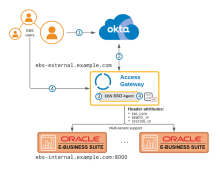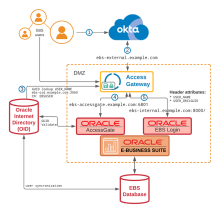Add an Oracle E-Business Suite application
Oracle eBusiness Suite can be integrated with Access Gateway in one of two ways, typically referred to as Classic and Rapid.
- With Classic, Oracle EBS Oracle Access Gate and either Oracle Internet Directory (OID) or Oracle User Directory (OUD) are required.
- With Rapid, Oracle EBS requires a set of EBS credentials and an EBS DCS file.
This application uses header variables to exchange user information. Access Gateway provides a sample header application. See Add a generic header application and Add a sample header application.
Architecture

|

|
|
EBS Rapid process flow
|
EBS Classic process flow
|
| For details, see Oracle E-Business Suite with Access Gateway Rapid SSO reference architecture | For details, see Oracle E-Business Suite with Access Gateway Classic SSO reference architecture |
| Oracle E-Business Suite applications differ from traditional applications in that Access Gateway creates and provides a EBS session cookie used by subsequent EBS calls. Access Gateway does not reverse proxy all EBS requests as is done with other application types. | |
Before you begin
Ensure that:
- Access Gateway is installed and configured. See Manage Access Gateway deployment.
- Access Gateway uses your Okta tenant as an Identity Provider (IdP). See Configure your Okta org as an Identity Provider.
- You have administrator rights on your Okta tenant and can create groups and assign applications.
- The external app version is supported. Oracle E-Business suite supported versions include:
- v12.1
- v12.2
For Classic process flow, ensure that:
- Oracle E-Business Suite(EBS) is configured with Oracle Access Gate and Oracle Internet Directory (OID) or Oracle User Directory (OUD).
For Rapid process flow, ensure that:
- Oracle E-Business Suite(EBS) is configured and available.
- DBC File has been created by the Oracle EBS owner and is available to the Access Gateway administrator. See Add an Oracle E-Business Suite application for instructions on how to configure Oracle E-Business Suite for Rapid SSO.
Rapid EBS SSO uses domain cookies to communicate between Access Gateway and the EBS server. The domain used by the protected service and the externally facing instance of the gateway must share the same domain.
- EBS_USER is mapped to an Okta tenant user.
Typical workflow
| Task | Description |
|---|---|
| Create a containing group |
|
|
[Rapid Only] Configure EBS for use with Access Gateway. |
|
| Create the EBS application |
|
| Test the application |
|
| Troubleshoot |
|
